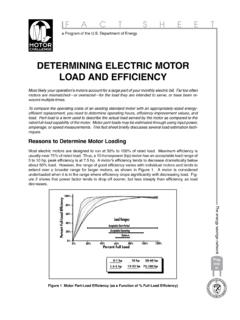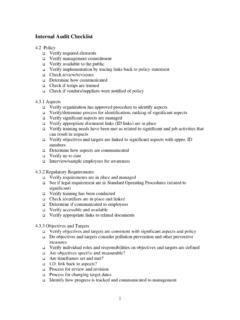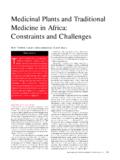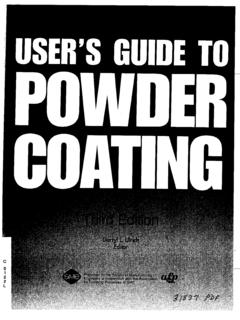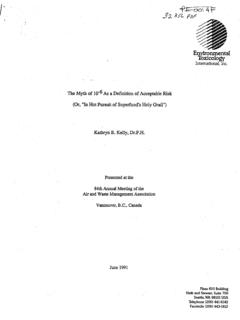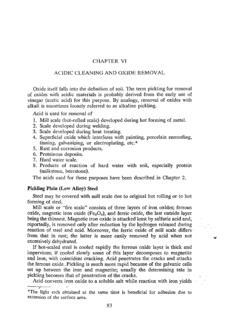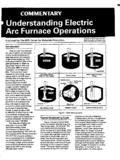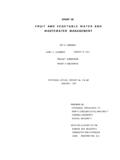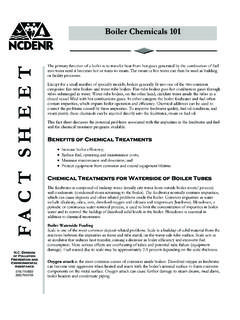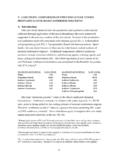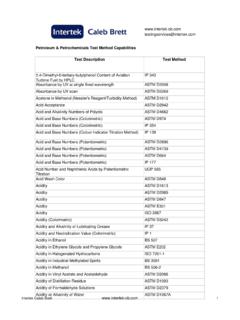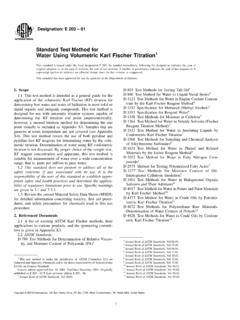Transcription of Antifreeze Recycling Using The Glyclean System - InfoHouse
1 Antifreeze Recycling Using THE Glyclean System ROBERTC. MILLER, JR. VICE PRESIDENT, RESEARCH AND DEVELOPMENT FPPF CHEMICALCO., INC The following report was presented at the Hazardous Materials Management Conference & Exhibition of Canada, in September c t I FPPF CHEMICAL CO., INC. Antifreeze Recycling Using THE Glyclean System FUEL ADDITIVES TREATMENTS CONDITIONERS L d..FFFT-\ BY ROBEX" C, MILLER, JR. VICE PRESIDENT, RESEARCH AND DEVELOPMENT FPPF CBEMICAL CO. INC 117 WEST TUPPER STREET BUFFALO, NY 14201 WHY USE A COOLANT IN ENGINES Antifreeze or antiboil or simply a coolant is used today in almost all types of internal combustion engines. Whether the fuel is gasoline, diesel, propane, natural gas or the heavier fuels such as #4, #6 or Bunker C, most all engines need to employ the use of some liquid medium to remove heat from the combustion area.
2 In water cooled engines, water passes through a jacket surrounding the combustion chamber, absorbes the heat, and transmitts it to a radiator where it can be dissipated to the air. Since the 1950's the most common choice of coolant has been a 1:l mixture of ethylene glycol and water, with the ethylene glycol containing selected inhibitors. Whether it is called Antifreeze in the colder parts of the world or antiboil in the warmer zones the coolant's function is to depress the freeze point for winter operation or raise the boiling point for warmer weather operation. Pure 100% ethylene glycol freezes at +9OF (-14O). water freezes at +32OF ( O C ) but a 1:1 mixture freezes at -34OF.
3 Most engine manufacturers recommend and provide a factory fill of a 1:l mixture or 50% ethylene glycol with 50% water. In continuous extreme cold weather operation up to 70% ethylene glycol and 30% water is in use. -. -2- Although ethylene glycol does not meet all the requirements of a coolant, it provides a fairly good overall balance. It has a specific heat of about 60 percent that of water, but a 50:50 mixture of ethylene glycol and water raises this to about 80 percent. In addition, a 50 percent solution has a 15OF (7OC) higher boiling point than water alone and this provides a definite The function of the coolant is, very simply, to remove some of the heat from the engine, be it automotive, truck, bus, locomotive, etc.
4 In actuality the hotter an engine runs, up to a point, the more efficient a machine it becomes. However, cooling is necessary to prevent lubricating oils from breaking down and thus protecting against serious expensive metal wear of critical moving parts. Engine cooling is more critical in diesel engines because diesel engines run hotter due to the longer vertical distance (higher compression ratio) the piston moves within the cylinder. Most diesel engines utilize what is called a "wet sleeve" or "cylinder liner" around the outside of the piston. This cylinder liner is designed to allow for the flow of coolant to remove the heat from the walls of the cylinder so the film of oil formed between the piston rings and cylinder walls is not thermally degraded.
5 If this heat was not removed, the oil would start to varnish, piston rigs would wear, cylinder liners would scorch and loss of power would result. Combustion gases would blow past the piston rings and introduce corrosive sulfur and other gases in the lubricating oil which would cause corrosion of metals in contact with the oil. Cooling System deposits, corrosion, cavitation and pitting of surfaces, all have a negative effect on heat transfer, so clean surfaces are important. Detroit Diesel has proven that as little as 1/16 inch of hard water scale on a cylinder liner has the heat insulating properties equal to 4 1/4 inches of cast iron in heat tran~ferability.
6 ~ It has been estimated by the major diesel engine manufacturers (Cummins, Detroit Diesel, Caterpillar, Perkins, etc.) that from 40% to 60% of diesel engine problems or failures were directly or indirectly caused by improper coolant treatment, neglected coolant or chemically depleted coolant. -3- In automobiles coolant maintenance is less critical due to what had previously been the extensive use of large flow cast iron cylinder blocks and valve heads. However, the increasing use of aluminum engines is presenting problems of a different nature. The need for a coolant for engines and the wide acceptance to the use of ethylene glycol produces ultimately a large consuming public.
7 With ethylene glycol production in the United States of around 500,000,000 gallons per year and approximately 250,000,000 gallons produced as Antifreeze for various vehicles, the changing and disposal of Antifreeze has become an environmental problem. TYPES OF COOLANTS ethylene glycol is by far the most widely used coolant in use today. Some engine manufacturers are, and have, experiment- ed with propylene glycol , but the cost, physical properties and higher operating temperatures (poor heat release) have kept propylene glycol from widespread use. Chemically, about l/2 cup of pure ethylene glycol if ingested could be fatal to an average size man. Propylene glycol is far less toxic and is even produced in a food grade as a heat transfer medium in food production.
8 * Pure 100% ethylene glycol or propylene glycol if discharged to the environment breaks down very quickly from ultra violet rays into harmless components and water. Some types of coolants are being promoted as "non-toxic" or "easily discharged - non polluting" as alternatives to ethylene glycol . It does not matter what the coolant fluid is, what matters are the levels of toxic heavy metals it contains after having been in an engine. Drained, used coolant typically will contain, in either dissolved or suspended form, significant quantities of iron, copper, lead, tin, zinc and smaller quantities of silver, cadmium and aluminum. It is these metals that most sewage treatment authorities are unable to remove or remain in the ground if dumped.
9 There are applications where coolant can be ordinary water and the use of ethylene glycol is not needed for freeze or boil protection, such as stationary indoor or shipboard engines. Inhibitors such as chromate, nitrite, molybdates are used to protect the metal surfaces. -4- Since inhibited ethylene glycol is by far the most widely used and accepted coolant product and the topic of disposal, the rest of this discussion shall only include the ethylene glycol coolant solution. INHIBITED COOLANTS Pure uninhibited ethylene glycol has a pH of slightly below so it is, in most situations, slightly acid. Depending on the source of the water used for dilution, the final solution can produce a coolant pH anywhere from to as high as The most typical final solution pH is usually around - Our extensive testing has shown us a coolant pH below is not acceptable for use in engines due to its corrosive nature.
10 Typical of gasoline and diesel engines is the use of cast iron, mild steel, aluminum, copper, lead, tin, zinc to name the most common. The corrosion potential between dissimilar metals due to galvanic coupling is very high. The diluent water contains oxygen and since all engines cool, ambient air is introduced which contains about 20% oxygen, thus providing a continuing release of oxygen bubbles which cause pittings of metal surfaces. To protect engines from corrosion and pitting of metal surfaces Antifreeze manufacturers employ inhibitors and other additives in their product such as nitrites, silicates, borates, MBT (mercaptobenzothiazole), antifoam, molybdates, silicones, dye, phosphates, surfactants and alkalinity builder.
